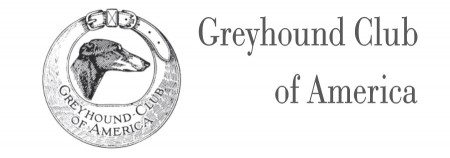This time, I would like to focus on judging priorities as seen by members of the Greyhound Club of America’s Education Committee. Contributors to this article include June Matarazzo, Pamela Noll, Cynthia Swanson, and myself. These committee members have over 125 years of greyhound experience combined and have these thoughts to share. While the term judging priorities indicate that this information is for judges, it is also for the information of breeders, exhibitors, and the public that may be choosing their first greyhound.
There was total agreement in the first item to be considered and that is the Outline of the greyhound. The greyhound has a distinct silhouette, with smooth, flowing curves from nose to tail including a slight rise over the loin. The greyhound is both elegant and substantial, with the appearance of great power, agility and speed. This athlete has an overall appearance of balance, with nothing extreme. Said another way, the appearance of a curvaceous body is the hallmark of the breed. Every good greyhound is a collection of curves and powerful muscling from neck, topline, underline, front and rear angulation and tail. All must be curved properly and with muscle. A body with curves and muscling in the right places are necessary characteristics for this breed to function as the fastest sighthound, coursing after all types of game in all types of terrain. What is incorrect and should be considered faulty? The lack of proper curves, ewe necks, completely level toplines, flatness across the loin, straight up-and-down shoulder angles, forearm assemblies set on forward of the breast bone, straight underlines from brisket to loin, straight stifles and hocks, and a stiff, straight tail are all faulty and should penalized according to the severity.
Movement - The greyhound is as indicated above the fastest of all sighthounds and as mentioned in the last column, greyhound movement is characterized by the double suspension gait not the trot. That gait is not practical for the ring so to that end, what should you see at the trot? You should see smooth, long, and low strides with the appearance of moving effortlessly Movement in the ring must be purposeful, elastic, and light. The topline is relaxed and not rigid. Tremendous reach and drive should not be rewarded. Incorrect movement that can be seen in the ring today include short, stiff, or choppy strides; pounding on the forehand, single-tracking, hindquarters tucked-under so the dog lacks drive, and a hackney gait.
Balance – Our dogs are called the long dogs and said to stand over ground. A greyhound is a rectangle, slightly longer than tall but not a lot longer than tall. A greyhound should be up on leg with a medium-sized body on long, strong legs. A greyhound with a very long mid-piece, or body mass, compared to his leg length is losing breed type. A well laid back shoulder, consistent for a sighthound; with a humerus of sufficient length to avoid the straight up look, and balanced angulation in the rear are all necessary components of balance. Greyhound angulation, front and rear, is moderate and should never give the impression of being extreme.
In closing, evaluating the outline, the movement, and balance in both what you see on the stack and on the move, tells you what you need to know!
